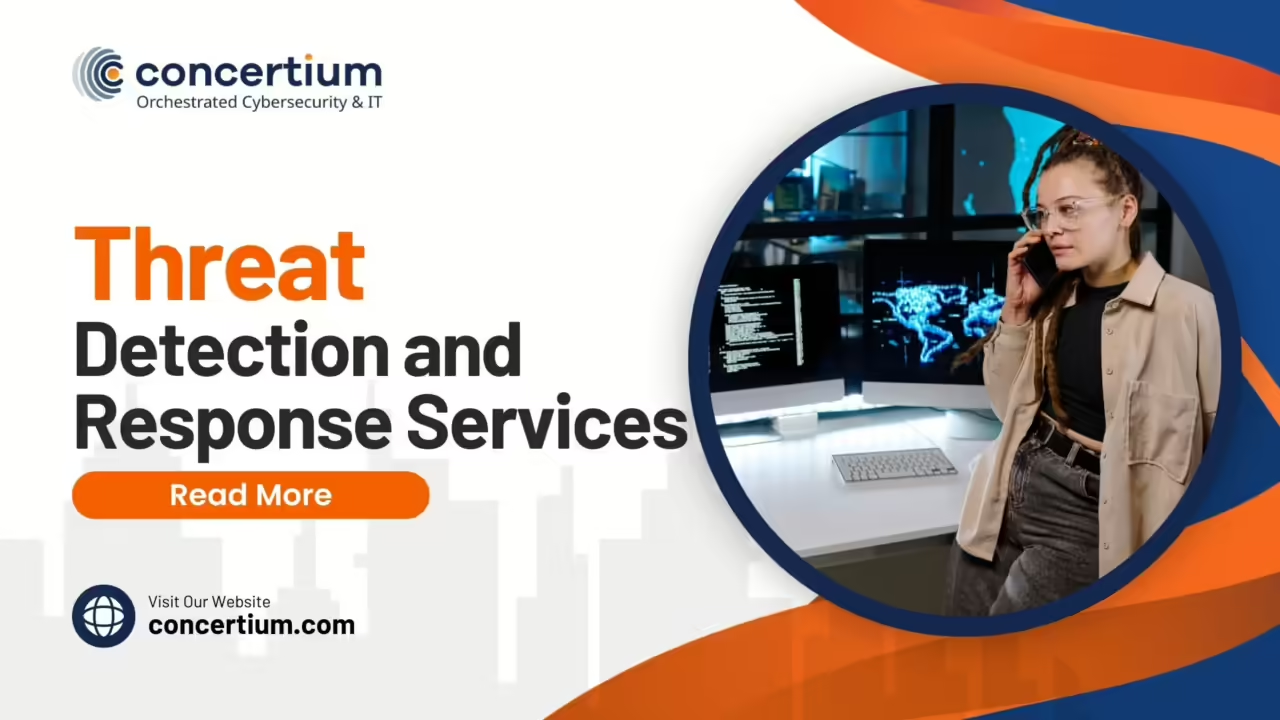Threat Detection and Response Services
Cybersecurity has become a critical concern for organizations of all sizes. As cyber threats continue to evolve in complexity and frequency, businesses must adopt comprehensive strategies to protect their digital assets.
One of the most effective approaches is Threat Detection and Response (TDR). This article explores the significance of TDR in modern cybersecurity frameworks and how it helps in safeguarding organizations against potential threats.
Understanding Threat Detection and Response
What is Threat Detection and Response (TDR)?
Threat Detection and Response (TDR) is a cybersecurity methodology that combines proactive threat detection with rapid incident response. TDR aims to identify and mitigate security threats before they can cause significant damage. By continuously monitoring networks, systems, and endpoints, TDR solutions can detect unusual activities and respond swiftly to neutralize threats.
- Definition and Explanation of TDR: TDR is the process of identifying potential threats through continuous monitoring and analysis, followed by timely actions to mitigate these threats.
- The Role of TDR in Cybersecurity: TDR plays a crucial role in enhancing an organization’s security posture by providing real-time visibility into security incidents and enabling swift responses.
- Benefits of Implementing TDR Solutions: Improved threat detection capabilities, faster incident response times, reduced risk of data breaches, and enhanced overall security.
Key Components of TDR
Threat Detection
Threat detection is the process of identifying potential threats to an organization’s network, systems, or data. This is achieved through various methods and technologies designed to monitor and analyze activities.
- Methods of Threat Detection: Signature-based detection, anomaly-based detection, and behavioral analysis.
- Types of Threat Detection Systems (IDS, IPS):
- Intrusion Detection Systems (IDS): Monitors network traffic for suspicious activities and alerts administrators.
- Intrusion Prevention Systems (IPS): Not only detects but also takes preventive actions against detected threats.
- Detection Technologies and Tools: Security Information and Event Management (SIEM) systems, Endpoint Detection and Response (EDR) tools, and Network Traffic Analysis (NTA).
Threat Response
Threat response involves the actions taken to mitigate or eliminate detected threats. This includes a series of steps and procedures aimed at minimizing the impact of a security incident.
- Incident Response Processes: Preparation, identification, containment, eradication, recovery, and lessons learned.
- Response Tools and Technologies: Automated response tools, incident response platforms, and threat intelligence services.
- Importance of a Quick and Efficient Response: Reducing the time between threat detection and response minimizes the potential damage and recovery costs.
Types of Threat Detection Systems
Intrusion Detection Systems (IDS)
Intrusion Detection Systems (IDS) are designed to detect unauthorized access or activities within a network. They analyze network traffic and generate alerts when suspicious patterns are identified.
- How IDS Works: IDS monitors network traffic in real-time, compares activities against a database of known attack signatures, and flags anomalies.
- Benefits and Limitations of IDS: Provides visibility into network activities and early warnings of potential threats, but it cannot take preventive actions.
Intrusion Prevention Systems (IPS)
Intrusion Prevention Systems (IPS) extend the capabilities of IDS by not only detecting threats but also taking preventive measures to block or mitigate them.
- How IPS Works: IPS actively monitors network traffic, detects malicious activities, and automatically blocks or mitigates these threats.
- Differences Between IDS and IPS: While IDS only alerts administrators about potential threats, IPS takes immediate actions to prevent them.
- Benefits of IPS: Provides an additional layer of security by actively preventing threats, reducing the burden on security teams.
Advanced Threat Detection Technologies
Endpoint Detection and Response (EDR)
Endpoint Detection and Response (EDR) is a security solution designed to monitor and respond to threats on endpoints such as computers, mobile devices, and servers.
- What is EDR?: EDR solutions provide continuous monitoring and analysis of endpoint activities to detect and respond to security incidents.
- Key Features of EDR Solutions: Real-time monitoring, threat detection, incident response, and forensic analysis.
- How EDR Enhances Threat Detection and Response: By providing detailed visibility into endpoint activities, EDR enables faster detection and response to threats.
Extended Detection and Response (XDR)
Extended Detection and Response (XDR) is an advanced form of EDR that integrates multiple security products into a unified platform for more comprehensive threat detection and response.
- Definition and Overview of XDR: XDR unifies data from various security products, including EDR, network security, and cloud security, to provide a holistic view of threats.
- Differences Between EDR and XDR: While EDR focuses on endpoints, XDR extends its capabilities across the entire IT environment.
- Benefits of Implementing XDR Solutions: Improved threat detection accuracy, streamlined incident response, and reduced complexity in managing multiple security products.
Managed Detection and Response (MDR)
What is MDR?
Managed Detection and Response (MDR) is a service that provides organizations with advanced threat detection and response capabilities, managed by third-party security experts.
- Explanation of MDR Services: MDR combines technology and human expertise to monitor, detect, and respond to threats on behalf of organizations.
- Benefits of MDR for Businesses: Access to expert security analysts, 24/7 threat monitoring, and improved threat detection and response without the need for in-house resources.
- How MDR Integrates with Existing Security Operations: MDR services work alongside existing security tools and processes, enhancing an organization’s security posture.
Managed Detection and Response vs. Traditional Security
MDR offers several advantages over traditional security measures by providing continuous monitoring and expert analysis, which are often lacking in traditional approaches.
- Comparison Between MDR and Traditional Security Measures: Traditional security often relies on in-house resources and may lack continuous monitoring, whereas MDR offers 24/7 threat detection and response.
- Advantages of Using MDR: Enhanced threat detection and response capabilities, access to specialized security expertise, and reduced burden on internal IT teams.
Best Practices for Effective Threat Detection and Response
Building a Robust TDR Program
A well-structured TDR program is essential for effective threat detection and response. This involves setting up processes, tools, and teams to manage threats proactively.
- Steps to Establish a TDR Program: Define objectives, identify key stakeholders, select appropriate tools, and develop incident response procedures.
- Importance of Continuous Monitoring and Improvement: Regularly update and test the TDR program to adapt to evolving threats and ensure effectiveness.
- Role of Threat Intelligence in TDR: Utilize threat intelligence feeds to stay informed about the latest threats and trends, enabling proactive threat hunting and response.
Integrating Threat Intelligence
Threat intelligence is critical for understanding the threat landscape and making informed decisions about threat detection and response.
- What is Threat Intelligence?: Information about current and emerging threats gathered from various sources.
- Sources of Threat Intelligence Feeds: Open-source intelligence, commercial threat intelligence providers, and internal threat data.
- How to Use Threat Intelligence for Proactive Threat Hunting: Incorporate threat intelligence into TDR processes to identify and mitigate threats before they can cause harm.
Proactive Threat Hunting
Proactive threat hunting involves actively searching for potential threats within an organization’s environment rather than waiting for alerts from automated systems.
- Definition and Importance of Threat Hunting: Threat hunting is the proactive search for threats that may evade automated detection systems, enhancing overall security.
- Tools and Techniques for Effective Threat Hunting: Utilize advanced analytics, threat intelligence, and specialized hunting tools to identify and respond to threats.
Incident Response Planning
Developing an Incident Response Plan
An incident response plan is a crucial component of any TDR program. It outlines the steps to be taken when a security incident occurs, ensuring that the organization can respond effectively to mitigate damage.
- Key Components of an Incident Response Plan:
- Preparation: Establish policies, tools, and resources necessary for effective incident response.
- Identification: Detect and identify potential security incidents through monitoring and alerts.
- Containment: Isolate affected systems to prevent the spread of the incident.
- Eradication: Remove the threat from the environment, ensuring that it cannot recur.
- Recovery: Restore systems and data to normal operation, verifying that the threat has been eliminated.
- Lessons Learned: Analyze the incident and response to improve future preparedness.
- Steps to Create an Effective Incident Response Plan:
- Conduct a risk assessment to identify potential threats and vulnerabilities.
- Define roles and responsibilities within the incident response team.
- Develop and document response procedures for different types of incidents.
- Train staff on their roles and the procedures to follow during an incident.
- Regularly review and update the plan to address new threats and changes in the environment.
- Importance of Regular Updates and Testing:
- Periodically test the incident response plan through drills and simulations.
- Update the plan based on lessons learned from tests and actual incidents.
- Ensure that all stakeholders are aware of changes and their roles.
Incident Response Team and Roles
Having a dedicated incident response team with clearly defined roles and responsibilities is essential for effective threat response.
- Roles and Responsibilities Within the Incident Response Team:
- Incident Response Manager: Oversees the entire response process, coordinates with stakeholders, and makes critical decisions.
- Security Analysts: Monitor systems for threats, analyze incidents, and recommend response actions.
- IT Support: Implements technical measures to contain and eradicate threats, and assists in system recovery.
- Communications Specialist: Manages internal and external communications during an incident, including notification to affected parties.
- Legal and Compliance: Ensures that the response adheres to legal and regulatory requirements.
- Importance of Clear Communication and Coordination:
- Effective communication ensures that all team members understand their roles and responsibilities.
- Coordination among team members and with external parties (e.g., law enforcement, customers) is critical to a successful response.
- Training and Preparation for Incident Response:
- Conduct regular training sessions and drills to ensure team members are prepared for incidents.
- Update training materials to reflect changes in the threat landscape and incident response plan.
Tools and Technologies for TDR
Security Information and Event Management (SIEM)
Security Information and Event Management (SIEM) systems are a cornerstone of modern TDR programs, providing centralized visibility and analysis of security events.
- Overview of SIEM Systems:
- SIEM systems collect and analyze log data from various sources across the organization.
- They provide real-time monitoring, threat detection, and incident response capabilities.
- How SIEM Assists in Threat Detection and Response:
- Data Aggregation: Consolidates log data from multiple sources, providing a comprehensive view of security events.
- Correlation and Analysis: Uses correlation rules and machine learning to identify patterns and anomalies indicative of threats.
- Alerting and Reporting: Generates alerts for suspicious activities and provides detailed reports for investigation and compliance.
- Benefits and Limitations of SIEM:
- Benefits: Enhanced visibility into security events, improved threat detection, and streamlined incident response.
- Limitations: Can be complex to deploy and manage, requires significant resources and expertise.
Automated Threat Detection and Response Tools
Automation plays a vital role in modern TDR, helping organizations respond to threats more quickly and efficiently.
- Types of Automated Tools Available:
- Security Orchestration, Automation, and Response (SOAR): Automates incident response workflows and integrates with other security tools.
- Endpoint Detection and Response (EDR): Provides automated detection and response capabilities for endpoint threats.
- Threat Intelligence Platforms (TIP): Automates the collection, analysis, and dissemination of threat intelligence.
- How Automation Improves Threat Detection and Response:
- Reduces response times by automating repetitive tasks and workflows.
- Enhances accuracy and consistency in threat detection and response.
- Frees up security analysts to focus on more complex and strategic tasks.
Threat Detection and Response in Action
Challenges and Solutions in TDR
Implementing TDR solutions can be challenging, but understanding common obstacles and how to overcome them is crucial for success.
- Common Challenges Faced During TDR Implementation:
- Resource Constraints: Limited budget and staff resources can hinder the implementation of comprehensive TDR solutions.
- Complexity of Integration: Integrating TDR tools with existing systems and workflows can be complex and time-consuming.
- Evolving Threat Landscape: Constantly changing threats require continuous updates and improvements to TDR programs.
- Solutions to Overcome These Challenges:
- Resource Constraints: Prioritize investments in critical TDR components and consider managed services to augment in-house capabilities.
- Complexity of Integration: Use standardized integration frameworks and collaborate with experienced vendors for seamless deployment.
- Evolving Threat Landscape: Regularly review and update TDR strategies, tools, and training to stay ahead of emerging threats.
- Importance of Adaptability and Continuous Learning:
- Foster a culture of continuous improvement and learning within the organization.
- Stay informed about the latest developments in threat detection and response technologies and practices.
- Encourage collaboration and knowledge sharing among security teams and stakeholders.
What People May Also Ask
What is the difference between EDR and XDR?
EDR (Endpoint Detection and Response) focuses on monitoring and responding to threats at the endpoint level. XDR (Extended Detection and Response) extends these capabilities across the entire IT environment, integrating data from multiple sources for a more comprehensive view of threats.
How does MDR benefit small businesses?
Managed Detection and Response (MDR) provides small businesses with access to expert security analysts and advanced threat detection and response capabilities without the need for significant in-house resources. This allows them to effectively protect their assets and data.
What are the key components of an effective incident response plan?
An effective incident response plan includes preparation, identification, containment, eradication, recovery, and lessons learned. It should also define roles and responsibilities, response procedures, and communication protocols.
How often should threat detection systems be updated?
Threat detection systems should be updated regularly to address new threats and vulnerabilities. This includes updating signatures, threat intelligence feeds, and software patches. Regular reviews and testing are also essential to ensure effectiveness.
What are the latest trends in threat detection technologies?
The latest trends in threat detection technologies include the adoption of artificial intelligence and machine learning for advanced threat analysis, increased use of automation for rapid response, and the integration of threat intelligence feeds for proactive threat hunting.
Conclusion
Threat Detection and Response (TDR) is an essential component of modern cybersecurity strategies. By understanding the key components, best practices, and tools involved in TDR, organizations can enhance their ability to detect and respond to threats effectively.
Investing in TDR solutions and services can significantly improve an organization’s security posture, reduce the risk of data breaches, and ensure compliance with regulatory requirements.





